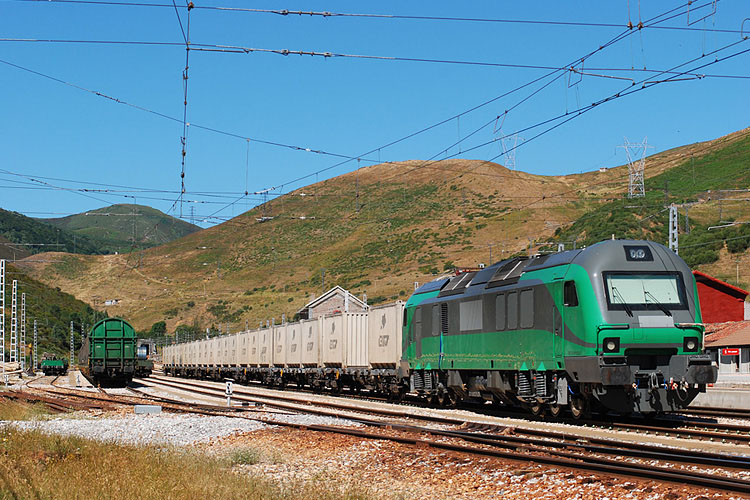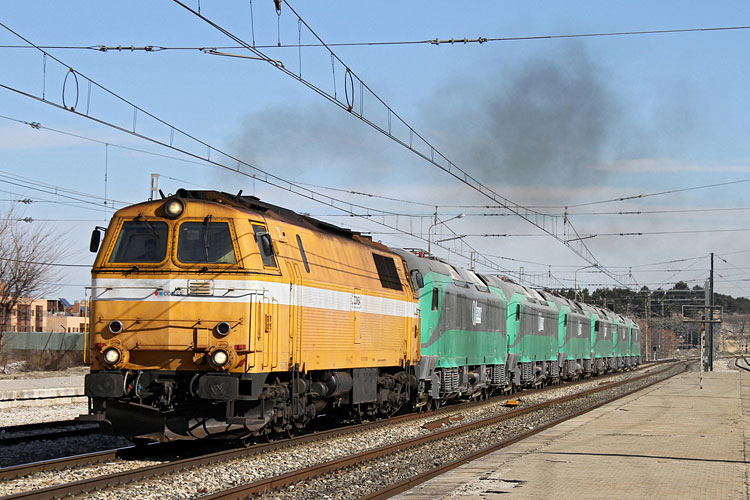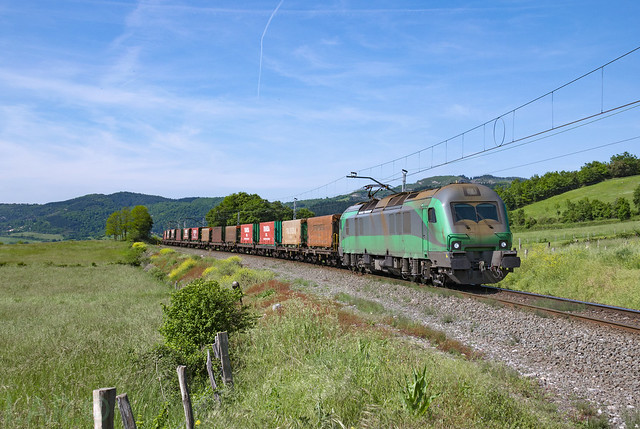|
|
|
In October 2007, the Spanish manufacturer Construcciones y Auxiliar de Ferrocarriles (CAF) published some first information on a new locomotive concept: the Bitrac. The Bitrac is a two-engine diesel-locomotive with additional equipment to run on 3kV DC catenary systems. Like many other locomotive solutions, the Bitrac was presented as a flexible platform. CAF published information on two basic versions; a four axle locomotive with 300 kN starting traction effort and a six axle version with 440 kN. Of course, the final specifications of Bitrac-products depend on what the market requires.
First customer for the Bitrac was Ferrocarriles del Suroeste SA (Fesur) from Spain. It was an open access operator, founded in 2007. Both Grupo Alfonso Gallardo and Gea21 own 50% of the shares. Jerez de los Caballeros (Badajoz) is the home base of Fesur. In 2008 it got a license to operate its own rail services. CAF built nine Bitrac BITRAC CC35600 for Fesur.


The homologation of the Bitrac locomoties was directed by rail operator Comsa. ADIF, the Spanish rail authority granted the Bitrac with a full approval in 2010. Early 2011, CAF delivered all nine machines to Fesur, but the company never operated them (see news for more information). All machines were returned to CAF, the last six of them arriving there on 21.02.2012. CVS (Compañía de Vagones del Sur) should have delivered 400 freight waggons to Fesur, but this contract was terminated too.
|
|
|
|
|
|
|
2016-06-07
|
[ES] Comsa starts Bitrac operation between Aranda de Duero - Bilbao
|
|
|
|
update 2016|06|07
[ES] Comsa starts Bitrac operation between Aranda de Duero - Bilbao

For the first time, Spanish freight rail operator Comsa is using Bitrac locomotives on a regular basis, outside the Pajares pass in Asturia. The machines have taken over from Euro 4000 diesel locomotives on the route Aranda de Duero - Bilbao, pulling the Tramesa steel coil trains.
Comsa now has six Bitrac units in its fleet: no. 601 003, 005, 006, 007, 008 and 009. Unit 601.004 is sat at León as parts donor/receiver. Its parts are being used for the machines in revenue service. CAF then deliveres new parts that are installed in the 004.
Curious: 601 003 is the newest addition to the Comsa fleet. When it started, it had a very very modest 1.100 km on its odometer. - Iñigo Arranz
|
|
|
|
|
|
2013-06-18
|
[ES] Dual Mode, electric and the Pajares Pass
|
|
|
|
update 2013|06|18
[ES] Dual Mode, electric and the Pajares Pass
An image report from Spain. Amazing images. - TL



|
|
|
|
|
|
2012-03-20
|
[ES] Comsa and its Bitrac
|
|
|
|
update 2012|03|20
[ES] Comsa and its Bitrac
 Comsa 95-71-0-601-006-0 during a technical stop in Campumanes station (Payares pass) with train 87220/1 (San Juan de Nieva - Ponferrada). - JLC
Comsa 95-71-0-601-006-0 during a technical stop in Campumanes station (Payares pass) with train 87220/1 (San Juan de Nieva - Ponferrada). - JLC
|
|
|
|
|
|
2012-03-06
|
[ES] Comsa operates Bitrac locomotive [updated]
|
|
|
|
update 2012|03|06
[ES] Comsa operates Bitrac locomotive [updated]

 Last week we had several posts about the CAF Bitrac locomotives. And indeed, freight operator Comsa was really interested in these machines. Now we can show you Bitrac no. 006 in revenue service. The main picture shows the locomotive on the Pajares pass. It leaves a tunnel after passing the Perruca climb, with its first commercial train. Last week we had several posts about the CAF Bitrac locomotives. And indeed, freight operator Comsa was really interested in these machines. Now we can show you Bitrac no. 006 in revenue service. The main picture shows the locomotive on the Pajares pass. It leaves a tunnel after passing the Perruca climb, with its first commercial train.
Comsa now no longer needs a seperate diesel locomotive for shunting trains that it brings over the Pajares pass.
Our thanks goes out to TrenSalamaca.com
|
|
|
|
|
|
2012-02-28
|
[ES] Spanish Dual Modes suffer from the economical crisis
|
|
|
|
update 2012|02|28
[ES] Spanish Dual Modes suffer from the economical crisis
(almost) nothing to do for TD2000 dual mode locomotives. CAF Bitrac for sale!

As we all know, Europe is in a crisis, and Spain is one of the members to take the hardest hits. Especially the housing market suffers hard, so it is no surprise that construction companies face difficult times since 2008. One of them is Grupo Alfonso Gallardo, involved in two freight transport projects in Spain, that both included the development of brand new dual-mode locomotive concepts: The CAF Bitrac platform for operator Fesur, and the Ingeteam TD2000 BB for EuskoKargo.
The TD2000s had to be used for the transport of steel for the Gallardo factory in Azpeitia, but this did not take of. Now the twelve TD2000's can do something for ArcelorMittal (10 runs a month appearantly), but most of the time they are parked at the Durango work shops.
 For the Fesur Bitrac locomotives, the situation is even worse. They were ordered to haul trains loaded with automobiles and trucks, but also this contract is cancelled. CAF did deliver all nine units to Fesur early 2011, but they have only been operated by Comsa since then. Comsa hired unit 601.001 and 002 for a while when suffering some traction shortage. The images show six of nine units being transported back from Linares-Baeza, were Fesur stored them, to Alusua, close to the CAF factory in Beasain. The other three are already there. All nine units are from now on up for sale and/or hire. For the Fesur Bitrac locomotives, the situation is even worse. They were ordered to haul trains loaded with automobiles and trucks, but also this contract is cancelled. CAF did deliver all nine units to Fesur early 2011, but they have only been operated by Comsa since then. Comsa hired unit 601.001 and 002 for a while when suffering some traction shortage. The images show six of nine units being transported back from Linares-Baeza, were Fesur stored them, to Alusua, close to the CAF factory in Beasain. The other three are already there. All nine units are from now on up for sale and/or hire.
BTW: The maker of the pictures has more splendid images to offer: check his Flickr account. Our favorite :).
sources: KAR/HD/OLH/BLG/Spoorwegen2012
|
|
|
|
|
|
2009-10-13
|
[ES] pictures of the CAF Bitrac dual-mode locomotive
|
|
|
|
update 2009|10|13
[ES] pictures of the CAF Bitrac dual-mode locomotive
Not entirely up to date, but as we saw some first images of the CAF Bitrac for operator Ferrocarrlies Suroccidentales (Fesur) in the 4/09 issue of Railvolution, we started a search on the internet. The first Bitrac was already spotted this July, and a first small image can be found here. Anyone who knows more?
|
|
|
|
|
|
2007-10-18
|
[ES] CAF developes new Bitrac locomotive concept for Fesur
|
|
|
|
update 2007|10|18
[ES] CAF developes new Bitrac locomotive concept for Fesur
BITRAC - A New Locomotive Concept
CAF has developed a locomotive platform called BITRAC. This name comes from the double possibility of travelling on electrified or non-electrified lines. The locomotives conform to the compulsory legislation and standards applicable within Spain and the European Community.
The BITRAC concept is supported with a system allowing for travel with diesel-electric traction on non-electrified lines and electric traction on electrified lines. Another important concept that has been incorporated is the achievement of redundancy of all the main items of equipment that guarantee high service reliability. A double power unit is fitted with two diesel motors, each operating an alternator. Each alternator-rectifier supplies the traction inverters via IGBTs which, in turn, supply the corresponding three phase asynchronous traction motor and also an auxiliary converter with IGBT technology.
The BITRAC locomotive provides the capacity to install the equipment required for electric locomotive operation, adding the corresponding pantograph-circuit breaker-cut out-brake resistors chain. The traction equipment is therefore divided into two completely independent chains. This independence also includes the cooling systems, whereby in the hypothetical case of a failure in the traction chain, service can be continued with 50 percent of the locomotive power.
Regarding braking, the locomotives are fitted with two systems: Electric brake and Pneumatic brake. These are controlled and blended to achieve the different braking modes: retention brake, stopping brake, emergency brake and parking brake. Depending on facilities of the running network, the locomotives are prepared to fit the most innovative safety and communications technology; Digital ASFA, ERTMS, Train-Ground, etc.
The BITRAC locomotive is fitted with a control and diagnosis system consisting of microprocessors interconnected via MVB type buses with a man-machine interface by means of a colour LCD screen on the driving desk. The carbody is designed as a welded, self-supporting structure, prepared to obtain high energy absorption rates in the event of collision, guaranteeing maximum protection for the driving personnel.
The BITRAC locomotives platform has been designed both for freight and passenger transit, covering speeds ranging from 120 kilometres per hour to 180 kilometres per hour. They can also be produced to provide service on RENFE gauge tracks or on UIC international gauge tracks. Another important characteristic is the possibility of incorporating double axle bogies with a Bo'-Bo' configuration, or triple axle bogies with a Co'-Co configuration to adapt the locomotive to the necessary traction effort.
As a result of the launching campaign of this platform which is considered by CAF to be winner, the company has recently signed a contract for 9 locomotives for freight transport BITRAC CC35600 with FESUR for diesel-electric and electric traction. - CAF press statement
|
|
|
|
|
|
CAF Bitrac: Production list |
|
|